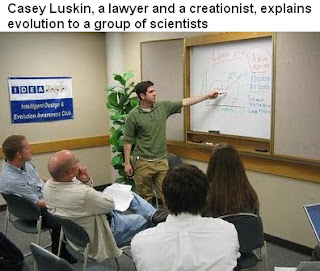Here's a link to the junk DNA debate between Dan Stern Cardinale and Casey Luskin. The debate took place on May 2, 2024.
I mentioned in a previous post that Luskin should have been called out on his repeated attempts to equate junk DNA with non-coding DNA. This allowed him to portray all non-coding functions as evidence against junk DNA. [Casey Luskin posts misleading quotes about junk DNA].
There are several other things that I would have done differently. I would have made it clear that 10% of the genome is functional and we don't know the function of some of that fraction. Thus, all newly discovered functional regions could still fit into the 10% and 90% of the genome is still junk. Every time Casey mentions a new function he should have been challenged to specify exactly what percentage of the genome he is referring to. (Dan tried to do this but he was too nice, and let Casey off the hook.)
The idea here is to make it clear to viewers that recent discoveries of functional regions do not affect the idea that most of our genome is junk.
I would also attempt to get Casey to admit that there's a scientific controversy over junk DNA so there are many papers defending junk DNA and criticizing the arguments of junk DNA opponents. For every quotation from a scientist who opposes junk, there's an equally significant quotation from one who supports junk. Why does Casey only quote scientists who agree with him? Is this cherry-picking? Is selectively rattling off quotations and references from people who agree with you a reasonable way to have a serious scientific debate?
I think the arguments over transcripts should begin with presenting all the scientific evidence that spurious transcripts exist - for example, random DNA sequences inserted into a cell nucleus are transcribed and spurious transcription is easily documented in well-studied organisms such as bacteria and yeast. The characteristics of spurious transcription are that the transcripts are present in very small amounts, that they are rapidly degraded, that they come from regions of the genome that are not under purifying selection, and they are cell/tissue specific. So what is the most reasonable explanation when you look at such transcripts?
Casey Luskin's attempt to avoid the best explanation (spurius transcription) is a classic example ad hoc rescue and it might have been useful to point this out to viewers.
Regulation is not new. There was serious discussion and debate over the amount of the genome devoted to regulation back in the late 1960s when the concept of junk DNA was first proposed. Casey should have been challenged to state what percentage of the genome is devoted to regulation and if he comes up with an unreasonable number he should have to give examples of many well-studied genes that have been shown to have that level of regulation. (Hint: There aren't any.) All of the detailed work on the regulation of dozens of specific human genes has shown that you don't need more than a few transcription factor binding sites to control expression. Is there any reason to suppose that the other genes require ten or a hundred times more regulatory sequences to control expression?
What is the trend line? Ever since the ENCODE publicity disaster of 2012 there has been a flood of papers defending junk DNA and the data supporting junk DNA is now stronger that it has ever been because we now know from hundreds of thousands of human genome sequences that only about 10% is under purifying selection. There have also been a lot of papers fleshing out the 10% of the genome that's functional. There have only been a handful of papers published in the past ten years that seriously attempt to present evidence that most of our genome is functional. I would have challenged Casey to come up with a single scientific publication in the past ten years claiming, with supporting data, that most of the genome is functional.

















